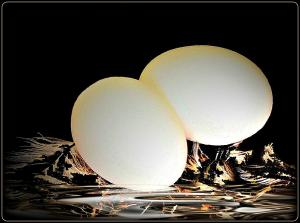You Didn't Ask...But : You Didn't Ask...But-#10-Eggs by Brett Matthew West Artwork by avmurray at FanArtReview.com |
 While the Christian festival, and cultural holiday, known as Easter 2023 is over, the actual Eastertide season extends fifty days to Pentecost. The Israelites would refrain from eating eggs during the forty day Passover Fast. This has been extended to include the recently new, three week long, Daniel Fast that eliminates meat, dairy, alcohol, and other "rich" foods in favor of eating vegetables.
While the Christian festival, and cultural holiday, known as Easter 2023 is over, the actual Eastertide season extends fifty days to Pentecost. The Israelites would refrain from eating eggs during the forty day Passover Fast. This has been extended to include the recently new, three week long, Daniel Fast that eliminates meat, dairy, alcohol, and other "rich" foods in favor of eating vegetables.
There have been several times in my life, especially when I was a pre-pubescent living on the cold streets of Nashville, when I had no idea where my next meal was coming from. People do like to eat, myself included. So, I thought why not take an up close gander at one of the most popular foods associated with Easter, the simple, or perhaps I should more correctly say, the not so simple Easter, or Paschal, egg? Many customs around the world have long used Easter eggs symbolically. Therefore, the question you may have at the moment is how do some civilizations utilize eggs to symbolize the Christian religion's Easter celebration? To many Christians, Easter eggs have a Trinitarian symbolism. For instance, the eggshell depicts the opening of Jesus' tomb. The egg white represents Jesus' burial shroud. And, the egg yolk stands for Jesus, the source of life. Were you aware of these representations? In general, eggs have long been associated with fertility and rebirth. Through the Orthodox Christian churches, this practice can be traced back at least to Mesopotamia, then to Russia, Eastern Europe, and on to Siberia. The early Christians of Mesopotamia also stained Easter eggs green and yellow. Catholic and Protestant churches brought Easter eggs to Europe. In Modern times, real eggs are often substituted with chocolate eggs wrapped in colored foil, hand-carved wooden eggs, or plastic eggs filled with confectionaries. Ah, the commercialization of another Christian tradition. Some of the oldest decorated eggs were engraved ostrich eggs found in Africa, Crete, and the pre-dynastic period of Egypt. These were associated with death, rebirth, as well as Sumarian and Egyptian kingships. Christian Easter eggs may have derived from the Persian Nowruz tradition. Still celebrated in Iran, the Middle East, and portions of Asia, Nowruz is the Persian New Year. This occurrence symbolizes revival and renewal. The Christian church officially adopted Easter eggs with the Roman Ritual, one of the official liturgical books of the Latin Church of Catholism. Easter eggs have been known about at least as far back as the 13th Century A.D. Although eating eggs was prohibited during the season of Lent, Christians would color, and otherwise decorate them, in homage of Lent's ending. Easter eggs are dyed red in Orthodox Christianity to represent Jesus' blood shed at His crucifixion. There are those in Greek Orthodoxy who believe the practice of Easter eggs represents a story of Mary Magdalene bringing cooked eggs to share during a vigil at Jesus' tomb. (See Luke 24:1-12). According to this tale her eggs turned red when the group learned Jesus had risen. There are egg hunts in the United States. Egg rolling down hillsides in England, Germany, and other countries is a preferred pasttime, as is egg tapping. Played in England, this game involves contestents hitting their opponents' eggs with theirs. The winner is determined by who possesses the last unbroken egg. Perhaps egg dances, or Easter Egg Plays, would be more up your alley? Anyway, can you see why the Easter egg is not necessarily so simple? You didn't ask...but.
|
| ©
Copyright 2025.
Brett Matthew West
All rights reserved. Brett Matthew West has granted FanStory.com, its affiliates and its syndicates non-exclusive rights to display this work. |



